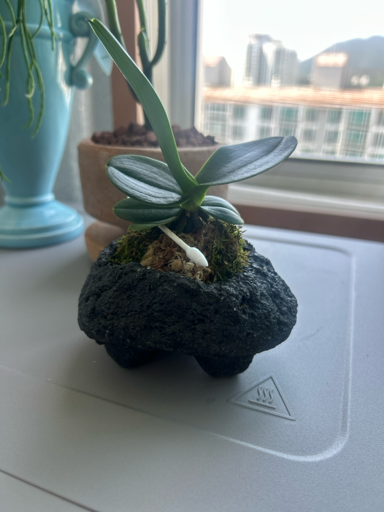How to grow and care for Sedirea japonica (Rchb. f.) Garay & H.R. Sweet
plant care guide about watering, fertilizing, trimming, repotting, cutting, propagating Sedirea japonica (Rchb. f.) Garay & H.R. Sweet
Sedirea japonica (Rchb. f.) Garay & H.R. Sweet 101 - Plant Care Instructions
Bright indirect light
21C° ~25C°
Every 7 days
Botany Encyclopedia
Family : Orchidaceae
🎋 Stem
It lacks a woody structure, and its stems are classified into two types: monocaule and polycaule. In monocaule, a single stem continues to grow, although new stems may emerge, with the original stem continuing to develop. In polycaule, the stem stops growing after reaching a certain height, and new stems emerge.
🪴 Root&Soil
They don't have fine roots, and their roots are thicker compared to other plants. They are broadly classified into epiphytic and terrestrial orchids. Epiphytic orchids grow attached to trees or rocks, while terrestrial orchids root in the ground.
Genus : Phalaenopsis
🏝️ Habitat Conditions
This plant primarily grows in Indonesia and the Philippines. It prefers warm and humid environments. It thrives when attached to trees or rocks and benefits from prolonged exposure to indirect light rather than direct sunlight.
🪨 Soil Mix
It is important to plant orchids in well-draining soil. Try using pumice or bark instead of potting soil.
🌡️ Environment
Daytime temperatures should be 20-25°C, and nighttime temperatures should be 15-25°C. In winter, the minimum temperature should be above 13°C. Flowers bloom in winter, but if the temperature stays below 20°C for too long, they may not grow well and could become deformed. Therefore, it's best to maintain temperatures above 20°C. Conversely, if the temperature stays above 25°C for too long, flower stalks may not form well. Above 25°C, stems and leaves grow well, while flowers bloom better at lower temperatures. Humidity should be between 40-70%. Be cautious of pests if the indoor environment is too dry. Plants prefer a humid environment, so ensure good air circulation to prevent mold growth.
☀️ Light
Plants thrive with prolonged exposure to indirect light. Placing them in a bright area can lead to larger leaves and lighter colors. Light also affects root growth, so it's beneficial to keep them in a bright environment.
💧 Water
For CAM plants, water them at night as they close their stomata during the day. From spring to fall, water when the surface soil is dry, and in winter, water when the deeper soil is dry. Ensure good air circulation after watering to prevent leaf damage from water accumulation.
🪴 Repot
Repot healthy plants every 2-3 years in spring, as they do not grow quickly.
💊 Fertilize
Use fertilizer 1-3 times a month during spring and summer, following the recommended dosage, to promote more vigorous growth.
🌺 Flower
The blooming period is in winter (December to February) and lasts for about 2-3 months. The plant can bloom 1-2 times a year. The flowers are showy but have little fragrance. If the temperature is maintained at 25°C during the blooming period, flower stalk development may be inhibited, preventing blooming. After the flowers fade, it is better to leave 2-3 nodes when cutting the flower stalk rather than cutting it too short.
😵 Toxicity
Non-toxic and safe for pets and children.
water
How to water Sedirea japonica (Rchb. f.) Garay & H.R. Sweet
💬 Gardener's know-how
How often should I water?
check Sedirea japonica (Rchb. f.) Garay & H.R. Sweet Every 7 days if it needs water when it’s very cold (below 5℃), water less frequently
When do I need to water?
the top 2-3 inches of soil is dry
Light & Location
How much light does a Sedirea japonica (Rchb. f.) Garay & H.R. Sweet need?

Bright indirect light
Grow light
Light preference
Sedirea japonica (Rchb. f.) Garay & H.R. Sweet likes Bright indirect light, Grow light day. The brighter the space, the better this plant grows.
Check if there’s an optimal place in your house!
This plant prefers
2K ~ 10K lux to thrive!
0
20K~
2K
10K
Temperature
Houseplants
-15
21~25℃
45
Plants that grow in the wild and those that grow indoors prefer different temperatures. If you grow Sedirea japonica (Rchb. f.) Garay & H.R. Sweet at home, make sure the temperature is 21~25℃.
Humidity
Ideal humidity
0
40~70%
100
Sedirea japonica (Rchb. f.) Garay & H.R. Sweet prefers humidity about 40~70%. If necessary, increase humidity by misting, humidifier.
Fertilize
Collective Knowhow
When should I fertilize?
Only when your plant is healthy
How frequently should I fertilize?
1-2 times in growing season. A pinch for a small pot.
Characteristic
The taxonomic classification of Sedirea japonica (Rchb. f.) Garay & H.R. Sweet is as follows. - Kingdom: Plantae, Phylum: Tracheophyta, Class: Liliopsida, Order: Asparagales, Family: Orchidaceae, Genus: Phalaenopsis, Species: Sedirea japonica (Rchb. f.) Garay & H.R. Sweet
| Characteristic Name | Characteristic Value |
|---|---|
| Habitat | Asia |
| Taxonomy Name | Taxonomy Value |
|---|---|
| Phylum | Tracheophyta |
| Class | Liliopsida |
| Order | Asparagales |
| Family | Orchidaceae |
| Genus | Phalaenopsis |
| Species | Sedirea japonica (Rchb. f.) Garay & H.R. Sweet |
Is your plant sick?
Track what happened. We’ll let you know the cause and treatment shortly!





1:1 Expert Help
You’ll get professional feedback within 24 hours from an expert on our team.
feedback will include










